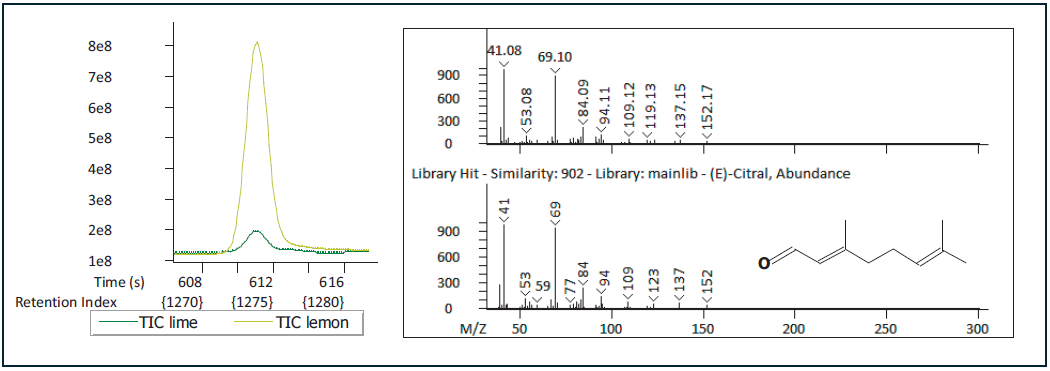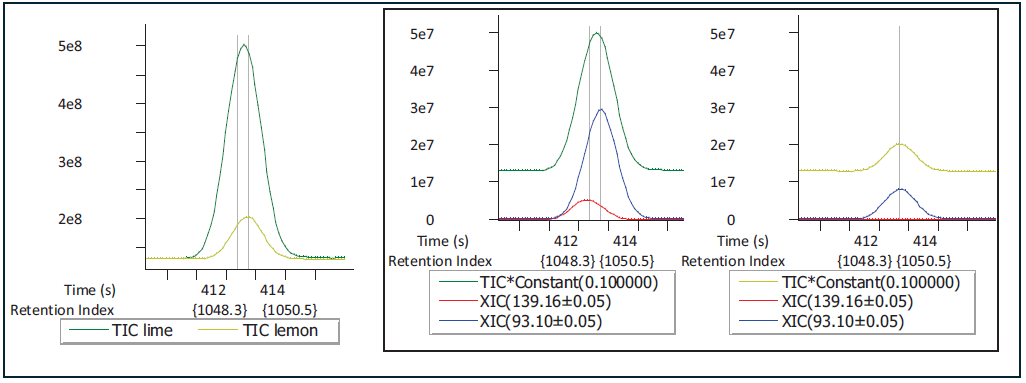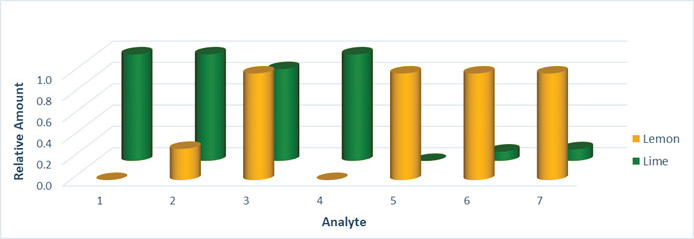Essential oils find diverse applications as they can be used as a finished product or an intermediate or ingredient to produce other products.
Such versatility of essential oils makes their study a key aspect of research with wide analytical objectives. The goals include authentication, quality control or general characterization for deeper learning of chemical composition in the essential oil and to identify the best way to use them in a product or process.
A combination of Gas Chromatography (GC) and Mass Spectrometry (MS) is a great tool for approaching the study requirements. Essential oils mainly consist of volatile and semi-volatile analytes that can be instantly identified, separated and quantified with GC-MS.
Successful separation is done chromatographically and using the mathematical deconvolution of the complete m/z range data. At the same time, the identification and quantification are realized through mass spectral data and peak profile integration, respectively, using a library search.
The outcome of this kind of GC-MS analysis is thorough chemical information on the constituents. This can meet a range of analytical goals. This study employed GC-MS to characterize and compare two citrus essential oils, namely, lemon and lime.
The individual chemical compositions are quantified and those with citrus odor notes are compared to better understand the similarities and differences in the citrus aroma profile of these materials. The study shows the advantages of full m/z range data, retention index determination and deconvolution for identifying other components in the sample.
Experiment
Essential oils of lemon and lime were diluted to 1% in acetone and tested with GC-TOFMS. This is described in Table 1. Information for an alkane standard (C6 through C24) was also gathered using the same techniques for Retention Index determinations.
Table 1. GC-TOFMS (Pegasus BT) conditions. Source: LECO Corporation
| Gas Chromatograph |
Agilent 7890 with LECO L-PAL 3 Autosampler |
| Injection |
1 uL, split 100:1 |
| Inlet |
250 °C |
| Carrier Gas |
He @ 1.4 mL/min |
| Column |
Rxi-5ms, 30 m x 0.25 mm i.d. x 0.25 μm coating (Restek) |
| Temperature Program |
40 °C ramp 10 °C/min to 280 °C |
| Transfer Line |
300 °C |
| Mass Spectrometer |
LECO Pegasus BT |
| Ion Source Temperature |
250 °C |
| Mass Range |
33-500 m/z |
| Acquisition Rate |
10 spectra/s |
Results and Discussions
Figure 1 depicts the representative GC-MS chromatograms for the essential oil of lemon and lime. Several similarities and differences can be noted in this data. LECO’s automated data processing software enables identification and offers relative quantification information for individual analytes.
This helped to gain more knowledge on the differences between the samples.

Figure 1. TIC Chromatogram for lemon and lime essential oils. Some key analytes with citrus odor types are highlighted. Image Credit: LECO Corporation
Three particular analytes, all featuring citrus odor descriptors, are denoted in Figure 1 and illustrated in Figures 2 to 5. The most powerful peak for the essential oils of both lime and lemon is limonene. This is highlighted with an asterisk in Figure 1 and depicted in Figure 2.
The identification was performed by comparing the observed spectral information with NIST library databases (similarity score = 936) and through comparison of the observed retention index (1033) to NIST library information for limonene (1030).
Limonene occurs in the essential oils of both lime and lemon at comparable levels. It features a citrus odor type that is described as herbal, terpene, citrus and camphor. It can possibly be a key contribution to both lime and lemon essential oils.

Figure 2. Limonene, with citrus odor characteristics, is present at comparable levels in both lemon and lime essential oils. Image Credit: LECO Corporation.
Other analytes featuring citrus odor types vary between the lemon and lime. For instance, (E)-Citral, illustrated in Figure 3, is found at higher levels in lemon essential oil than lime essential oil.
The identification was performed by comparing the acquired spectral data with NIST library databases (similarity score = 902) and through a comparison of observed retention index (1274) with NIST library information (1270).
(E)-Citral also features a citrus odor type and is defined as citrus and lemon. It is a key contributor to the lemon essential oil than to the lime. This variation possibly adds to the exclusive citrus properties of each oil.

Figure 3. E-citral, with citrus notes, is observed at higher levels in lemon than lime essential oil. Image Credit: LECO Corporation
The TIC view of the data clearly shows both limonene and (E)-Citral and their relative quantity in the samples because the analytes are chromatographically resolved in both instances.
In other cases where chromatographic coelution masks analyte variation, the data processing tools in the software help gain insights into the samples.
As illustrated in Figures 4 and 5, deconvolution specifically supported the research to evaluate the differences between the lime and lemon essential oils. From the TIC view illustrated in Figure 4, it is clear that one analyte is more in the lime essential oil than in the lemon essential oil.
Yet, the automated peak finding quantified the presence of two coeluting analytes. The two analytes and their unique trends can be traced with extracted ion chromatograms (XICs) for m/z that are exclusive to each analyte.
In Figure 4, the TIC has been shown at 10% together with XICs for m/z that are unique to each analyte (m/z 139.16 and 93.10, for instance).
This aspect reveals that there are detailed chromatographic profiles for every analyte and it also confirms the occurrence of different relative trends for both analytes. One exists in both samples, but at an increased level in lime. By contrast, the other one is only traced in the lime essential oil.

Figure 4. What appeared to be one analyte at higher levels in lime compared to lemon, was deconvoluted to two distinct analytes. One is higher in lime than lemon (m/z 93.10) and the other was only observed in lime (m/z 139.16). Image Credit: LECO Corporation
As illustrated in Figure 5, pure spectra for each of the analytes were also provided with deconvolution, leading to the identification of tetrahydro-2,2-dimethyl-5-(1-methyl-1-propenyl)-furan with citrus odor properties and trans-β-ocimene with herbal odor properties.

Figure 5. Tetrahydro-2,2-dimethyl-5-(1-methyl-1-propenyl)-furan, with citrus notes, and trans-β-ocimene, with herbal notes), were deconvoluted in the essential oil samples and both observed higher or only in the lime essential oil. Image Credit: LECO Corporation.
Furan identification was quantified by comparing the observed spectral information with NIST library databases (similarity score = 849) as well as a comparison of the observed retention index (1049) with NIST library information (1047).
Terpene identification was also determined through a comparison of the observed spectral information with NIST library databases (similarity score = 919) and by comparing the observed retention index (1049) with NIST library information (1049).
In Figure 5, the XICs are overlaid, indicating the relative amounts of these analytes in each sample.
Deconvolution was critical for quantifying the presence of terpene that is more in lime when compared to lemon and a furan that is only seen in the lime essential oil. This furan features citrus odor characteristics described further as citrus, sweet, spicy, herbal, minty, green, celery and woody.
It is potentially crucial for the differences in the citrus profile between the essential oils, and it would have been masked in the absence of deconvolution.
Citrus is an important descriptor of both lime and lemon essential oils, but the citrus notes of lime and lemon are not the same. This can be observed from the differences demonstrated in the analytes depicted in Figures 2 to 5.
The citrus aroma was investigated further by compiling data on other analytes in these samples that host citrus odor types.
The citrus aroma profile was identified by first pinpointing the analytes found in these samples and then screening the determined analytes for the ones that have citrus aroma type.
Identifications were performed by spectral matching with library databases and by verifying the retention index when available. This has already been illustrated in Figures 2 to 5.
After identification, the odor types were quantified with databases. Figure 6 shows seven analytes with citrus odor type. The related table collated the identification merits (Similarity score and Retention Index information) and shows the detailed and particular descriptions of the citrus odor notes.

| # |
Analyte |
Similarity |
CAS |
Formula |
tR
(s) |
RI
Obs |
RI
Lib |
Odor
Notes |
| 1 |
D-limonene |
838 |
5989-27-5 |
C10H16 |
331 |
960 |
|
citrus orange fresh sweet |
| 2 |
3-carene |
909 |
13466-78-9 |
C10H16 |
380 |
1014 |
1011 |
citrus terpenic herbal pine
solvent resinous phenolic
cypress medicinal woody |
| 3 |
limonene |
936 |
138-86-3 |
C10H16 |
398 |
1033 |
1030 |
citrus herbal terpene
camphor |
| 4 |
tetrahydro-2,2-
dimethyl-5-(1-methyl-
1-propenyl)- furan |
849 |
7416-35-5 |
C10H18O |
412 |
1049 |
1047 |
sweet citrus herbal green
celery spicy minty woody |
| 5 |
trans-limonene oxide |
852 |
4959-35-7 |
C10H16O |
498 |
1143 |
1138 |
fresh citrus |
| 6 |
(Z)-citral |
848 |
106-26-3 |
C10H16O |
587 |
1245 |
1240 |
sweet citral lemon peel |
| 7 |
(E)-citral |
902 |
141-27-5 |
C10H16O |
611 |
1274 |
1270 |
citrus lemon |
Figure 6. Citrus profile of lemon and lime essential oils. Image Credit: LECO Corporation.
The corresponding volume of each analyte is indicated in the associated bar chart with many evident variations. Limonene is traced at comparable levels in both samples, while all other analytes are present in higher levels in both lime or lemon.
A crucial fact here is that the analytes with higher lemon (trans-limonene oxide, (Z)-citral, and (E)-citral) have odor notes referred to as more lemony.
The analytes traced at higher levels in the lime essential oil (D-limonene, 3-carene and tetrahydro-2,2-dimethyl-5-(1-methyl-1-propenyl)-furan) hold odor notes depicted as being more herbal, orange and woody.
This citrus profile helps learn more about the exclusive citrus properties of each essential oil.
Conclusion
This article has illustrated the application of GC-MS to characterize and compare individual analyte components in the essential oils of lime and lemon. The analytical platform merges the chromatographic separation from GC with full m/z range non-skewed TOFMS detection. This enables the ideal performance of deconvolution algorithms.
Certain important differences unraveled by this data were masked by chromatographic coelution and would have been challenging to achieve in the absence of this deconvolution.
The comprehensive chemical data related to the presence of essential oil returned characterization information and enabled the differentiation of the specific chemicals that contribute to the citrus profile. It also helped to understand how these differ between both essential oils.

This information has been sourced, reviewed and adapted from materials provided by LECO Corporation.
For more information on this source, please visit LECO Corporation.